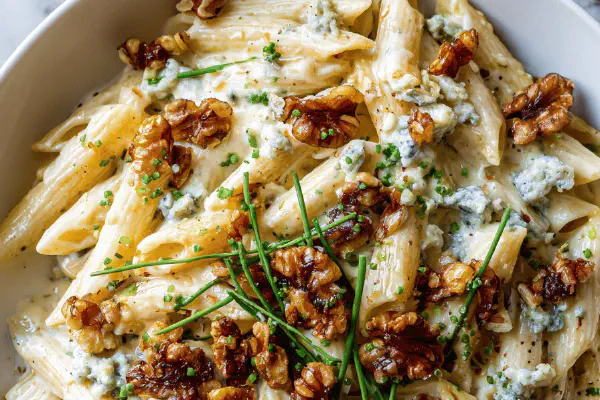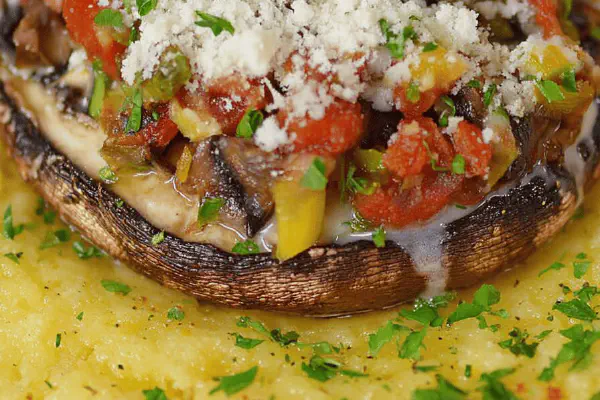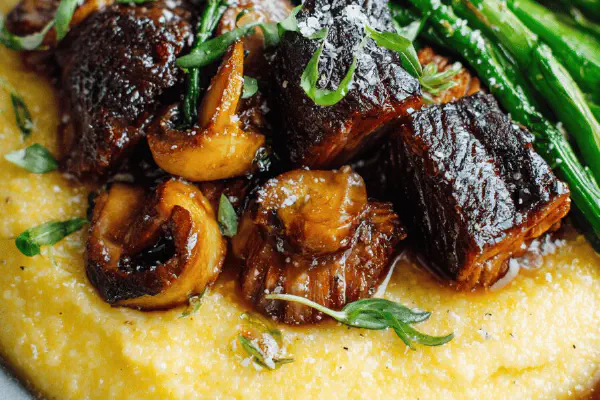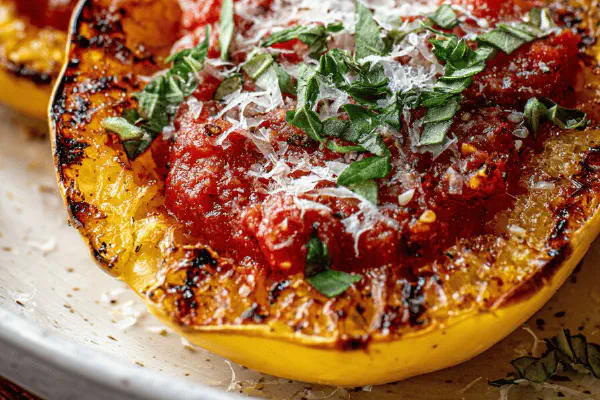Blue Cheese Walnut Penne

By Emma
Certified Culinary Professional
Ingredients
- 425 g penne or other short pasta
- 1 medium shallot minced
- 2 cloves garlic finely chopped
- 40 ml olive oil
- 150 ml dry white wine
- 150 ml heavy cream 15–35 %
- 100 g gorgonzola cubes
- 200 ml toasted pecan pieces
- 125 ml grated aged pecorino romano
- 50 ml fresh chives chopped
- Salt and pepper
About the ingredients
Method
- Boil large pot salted. Watch for pasta swelling and surface bubbles — toss in penne. Stir immediately to avoid stickiness. Cook till firm but tender, about 10–12 minutes, bite test your ally. Drain, toss with small drizzle of oil, stir to coat. Keeps pasta loose while awaiting sauce.
- Clean same pot, warm olive oil until shimmering but not smoking. Toss shallots in. Stir gently; soft translucence signals readiness. Add garlic, stir carefully, just until aroma rises. Overcooked? Bitter. Season lightly with salt and pepper now.
- Splash white wine. Listen for pop and sizzle as it hits the hot pan. Stir, reduce heat a little. Simmer to near dryness; watch liquid coat the pan bottom. One minute tops to avoid overpowering acidity.
- Pour cream in, stir steadily. Lower heat. Toss in gorgonzola cubes slowly, stir until melted but not grainy. Melt process delicate; too fierce heat breaks fats — cream breaks, sauce separates. Adjust heat accordingly.
- Add drained pasta back in. Fold gently, coating. Toss in pecans. Warm through 3–4 minutes. Watch for sauce thickening, clinging to noodles. Final taste check; balance salt and pepper. Chives last — stir in just before plating, preserve fresh brightness.
- Serve with generous sprinkle of pecorino. Garnish handful extra chives if you’re feeling extra herbal punch.
- Common fix: sauce too thin? Let simmer a bit longer, stir frequently. Sauce too thick? Splash more cream or white wine. Missing acidity? Add squeeze lemon juice or splash more wine after cream melts. Nuts can be toasted ahead or quick dry pan — watch for nutty aroma, not burnt.
Cooking tips
Chef's notes
- 💡 Cook pasta till firm but not mushy - bubbles swell, surface shimmer. Drain fast, toss with little oil right away. Prevent clumps; starch sticky but not gluey. Watch closely, rely on feel not clock. Drain doesn't equal done, bite tests always backup.
- 💡 Heat olive oil medium low till shimmer - never smoke. Add shallots first, stir gentle till translucent and soft, no browning that turns bitter. Garlic next, short stir till fragrant not dark. Aroma signals done stage, cooking too long makes sharp bitterness creep in fast.
- 💡 Deglaze pan with dry white wine, listen for pop, sizzle. Reduce heat slightly to simmer. Let wine reduce almost dry - thin layer, glossy bottom visible. Too long burns acidity; too little leaves harsh sharp flavor. One minute tops after bubbling starts is sweet spot worked out by smell and sheen.
- 💡 Add cream slow, stir steady, keep heat low. Toss in blue cheese cubes gently, melt just till smooth but not grainy. Watch for fat break - sauce separates if heat too high or rushed stirring. Cream fat percentage critical; higher fat steadies sauce, too low risks curdling.
- 💡 Fold drained pasta into sauce on low heat - gentle toss, no smashing. Add toasted nuts last for crunchy burst, warm through 3-4 minutes. Sauce thickens, clings to noodles, texture shifts. Reserve chives for final stir-in, preserves fresh sharpness over heat loss.
Common questions
How long to cook penne without mush?
Watch bubbles swell, surface change; texture still firm but soft. Bite test always best. 10-12 minutes average but varies by brand. Drain once teeth feel slight resistance. Keep little starchy water for sauce runoff if needed.
Can other nuts replace walnuts?
Yes, pecans popular swap for sweeter notes and easier chopping. Toast nuts dry pan till aroma hits your nose — no burns. Almonds or hazelnuts also work, different crunch and flavor. Adjust stirring time to warm without softening nuts too much.
Sauce broke — what now?
Heat too high or cheese melted too fast. Lower heat immediately, stir gently but consistently. Add splash cream if dry or break starts. If really separated, whisk cold cream in off heat to rescue smoothness. Patience with temperature key here.
Leftovers storage?
Store tight container fridge. Sauce thickens, loosen with splash cream or milk reheated gently. Skip microwave high heat; stove slow warm retains sauce integrity. Pasta absorbs sauce overnight, may need extra liquid to refresh texture. Eat within 2 days best.



